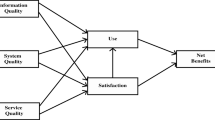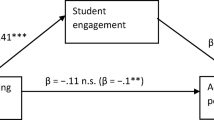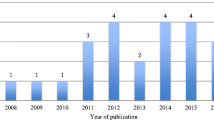Abstract
Previous research has produced contrasting findings regarding the influence of social networking on academic performance. Many have found negative relationships but some have also demonstrated a positive effect for social networking on academic performance. Still others report no links between social networking and academic performance. Researchers have attempted to explain these divergences by specifying the quality and frequency of social networking habits and behaviors, distinguishing between adaptive and maladaptive traits. Yet it remains unclear how divergent use patterns are related to academic performance. To extend this literature, we examine the relationship between frequency, duration, and problematic (i.e., maladaptive) use of social networking sites on perceived performance expectancy and actual academic performance of a sample of college-level students recruited at a pre-university program in Northeastern Canada. Our findings suggest that different measures of SNS use and academic performance can yield different links between social networking and academic performance. Interestingly, we find that frequency and problematic use of SNS are related to performance expectancy though we do not find a concomitant effect for reported academic performance. Findings are discussed with respect to self-determination theory and implications for teaching and learning are offered as well.
Similar content being viewed by others
Explore related subjects
Discover the latest articles, news and stories from top researchers in related subjects.References
Ahn, J. (2011). The effect of social network sites on adolescents’ social and academic development: Current theories and controversies. Journal of the American Society for Information Science and Technology, 62(8), 1435–1445. https://doi.org/10.1002/asi.21540.
Ainin, S., Naqshbandi, M. M., Moghavvemi, S., & Jaafar, N. I. (2015). Facebook usage, socialization and academic performance. Computers & Education, 83, 64–73. https://doi.org/10.1016/j.compedu.2014.12.018.
Alarcón-del-Amo, M.-C., Lorenzo-Romero, C., & Gómez-Borja, M.-ángel. (2016). Cultural influence on the adoption of social networking sites. International Journal of Market Research, 58(2), 277–300. https://doi.org/10.2501/IJMR-2016-015.
Alloway, T., Horton, J., Alloway, R., & Dawson, C. (2013). Social networking sites and cognitive abilities: Do they make you smarter?. Computers & Education, 63, 10–16. https://doi.org/10.1016/j.compedu.2012.10.030.
Alt, D. (2015). College students’ academic motivation, media engagement and fear of missing out. Computers in Human Behavior, 49, 111–119. https://doi.org/10.1016/j.chb.2015.02.057.
Baeten, M., Kyndt, E., Struyven, K., & Dochy, F. (2010). Using student-centred learning environments to stimulate deep approaches to learning: Factors encouraging or discouraging their effectiveness. Educational Research Review, 5(3), 243–260. https://doi.org/10.1016/j.edurev.2010.06.001.
Bazelais, P., Lemay, J. D., & Doleck, T. (2016). How does grit impact students’ academic achievement in science? European Journal of Science and Mathematics Education, 4(1), 33–43.
Blackwell, D., Leaman, C., Tramposch, R., Osborne, C., & Liss, M. (2017). Extraversion, neuroticism, attachment style and fear of missing out as predictors of social media use and addiction. Personality and Individual Differences, 116, 69–72. https://doi.org/10.1016/j.paid.2017.04.039.
Bobkowski, P. S., Shafer, A., & Ortiz, R. R. (2016). Sexual intensity of adolescents’ online self-presentations: Joint contribution of identity, media consumption, and extraversion. Computers in Human Behavior, 58, 64–74. https://doi.org/10.1016/j.chb.2015.12.009.
Doleck, T., Bazelais, P., & Lemay, D. J. (2017). Examining the antecedents of social networking sites use among CEGEP students. Education and Information Technologies, 22(5), 2103–2123. https://doi.org/10.1007/s10639-016-9535-4.
Doleck, T., & Lajoie, S. P. (2018). Social networking and academic performance: A review. Education and Information Technologies, 23(1), 435–465. https://doi.org/10.1007/s10639-017-9612-3.
Doleck, T., Bazelais, P., & Lemay, D. J. (2018). Social networking and academic performance: A generalized structured component approach. Journal of Educational Computing Research, 56(7), 1129–1148. https://doi.org/10.1177/0735633117738281.
Doleck, T., Lajoie, S. P., & Bazelais, P. (2019). Social networking and academic performance: A longitudinal perspective. Education and Information Technologies, 24(2), 1545–1561. https://doi.org/10.1007/s10639-018-9843-y.
CREPUQ. (2007). The R score: What it is, and what it does. Retrieved from http://www.johnabbott.qc.ca/wp-content/uploads/2014/05/R_score_what_it_is_English.pdf.
Duggan, M. (2015). The demographics of social media users. Pew Research Center: Internet, Science & Tech Retrieved from http://www.pewinternet.org/2015/08/19/the-demographics-of-social-media-users/.
Elhai, J. D., Dvorak, R. D., Levine, J. C., & Hall, B. J. (2017). Problematic smartphone use: A conceptual overview and systematic review of relations with anxiety and depression psychopathology. Journal of Affective Disorders, 207, 251–259. https://doi.org/10.1016/j.jad.2016.08.030.
Ellison, N., & Boyd, D. (2013). Sociality through social network sites. In W. H. Dutton (Ed.), The Oxford handbook of internet studies (pp. 151–172). Oxford: Oxford University Press.
Facebook Newsroom (2019). Stats. Retrieved from https://newsroom.fb.com/company-info/
Fosso Wamba, S., Bhattacharya, M., Trinchera, L., & Ngai, E. W. T. (2017). Role of intrinsic and extrinsic factors in user social media acceptance within workspace: Assessing unobserved heterogeneity. International Journal of Information Management, 37(2), 1–13. https://doi.org/10.1016/j.ijinfomgt.2016.11.004.
Goodman-Deane, J., Mieczakowski, A., Johnson, D., Goldhaber, T., & Clarkson, P. J. (2016). The impact of communication technologies on life and relationship satisfaction. Computers in Human Behavior, 57, 219–229. https://doi.org/10.1016/j.chb.2015.11.053.
Greenhow, C., & Askari, E. (2017). Learning and teaching with social network sites: A decade of research in K-12 related education. Education and Information Technologies, 22(2), 623–645. https://doi.org/10.1007/s10639-015-9446-9.
Hair, J., Ringle, C., & Sarstedt, M. (2011). PLS-SEM: Indeed a silver bullet. Journal of Marketing Theory and Practice, 19(2), 139–152. https://doi.org/10.2753/mtp1069-6679190202.
Halpern, D., Katz, J. E., & Carril, C. (2017). The online ideal persona vs. the jealousy effect: Two explanations of why selfies are associated with lower-quality romantic relationships. Telematics and Informatics, 34(1), 114–123. https://doi.org/10.1016/j.tele.2016.04.014.
Henseler, J., Ringle, C., & Sarstedt, M. (2014). A new criterion for assessing discriminant validity in variance-based structural equation modeling. Journal of the Academy of Marketing Science, 43(1), 115–135. https://doi.org/10.1007/s11747-014-0403-8.
Janković, B., Nikolić, M., Vukonjanski, J., & Terek, E. (2015). The impact of Facebook and smart phone usage on the leisure activities and college adjustment of students in Serbia. Computers in Human Behavior, 55, 354–363. https://doi.org/10.1016/j.chb.2015.09.022.
Junco, R. (2012). The relationship between frequency of Facebook use, participation in Facebook activities, and student engagement. Computers & Education, 58(1), 162–171. https://doi.org/10.1016/j.compedu.2011.08.004.
Junco, R. (2015). Student class standing, Facebook use, and academic performance. Journal of Applied Developmental Psychology, 36, 18–29. https://doi.org/10.1016/j.appdev.2014.11.001.
Karpinski, A. C., Kirschner, P. A., Ozer, I., Mellott, J. A., & Ochwo, P. (2013). An exploration of social networking site use, multitasking, and academic performance among United States and European university students. Computers in Human Behavior, 29(3), 1182–1192. https://doi.org/10.1016/j.chb.2012.10.011.
Kirschner, P. A., & Karpinski, A. C. (2010). Facebook® and academic performance. Computers in Human Behavior, 26(6), 1237–1245. https://doi.org/10.1016/j.chb.2010.03.024.
Krasnova, H., Widjaja, T., Buxmann, P., Wenninger, H., & Benbasat, I. (2015). Research note—Why following friends can hurt you: An exploratory investigation of the effects of envy on social networking sites among college-age users. Information Systems Research, 26(3), 585–605. https://doi.org/10.1287/isre.2015.0588.
Lee, Y. (2006). An empirical investigation into factors influencing the adoption of an e-learning system. Online Information Review, 30(5), 517–541 https://doi.org/10.1108/14684520610706406.
Lemay, D. J., Doleck, T., & Bazelais, P. (in press). Self-determination, loneliness, fear of missing out, and academic performance. Knowledge Management & E-Learning.
Lemay, D. J., Doleck, T., & Bazelais, P. (2019). Context and technology use: Opportunities and challenges of the situated perspective in technology acceptance research. British Journal of Educational Technology, 50, 2450–2465. https://doi.org/10.1111/bjet.12859.
Lundy, B. L., & Drouin, M. (2016). From social anxiety to interpersonal connectedness: Relationship building within face-to-face, phone and instant messaging mediums. Computers in Human Behavior, 54, 271–277. https://doi.org/10.1016/j.chb.2015.08.004.
Mahoney, J., Le Moignan, E., Long, K., Wilson, M., Barnett, J., Vines, J., & Lawson, S. (2019). Feeling alone among 317 million others: Disclosures of loneliness on twitter. Computers in Human Behavior, 98, 20–30. https://doi.org/10.1016/j.chb.2019.03.024.
Oberst, U., Wegmann, E., Stodt, B., Brand, M., & Chamarro, A. (2017). Negative consequences from heavy social networking in adolescents: The mediating role of fear of missing out. Journal of Adolescence, 55, 51–60. https://doi.org/10.1016/j.adolescence.2016.12.008.
Phua, J., Jin, S. V., & Kim, J. (Jay). (2017). Gratifications of using Facebook, twitter, Instagram, or Snapchat to follow brands: The moderating effect of social comparison, trust, tie strength, and network homophily on brand identification, brand engagement, brand commitment, and membership intention. Telematics and Informatics, 34(1), 412–424. https://doi.org/10.1016/j.tele.2016.06.004.
Pittman, M., & Reich, B. (2016). Social media and loneliness: Why an Instagram picture may be worth more than a thousand twitter words. Computers in Human Behavior, 62, 155–167. https://doi.org/10.1016/j.chb.2016.03.084.
Primack, B. A., Shensa, A., Escobar-Viera, C. G., Barrett, E. L., Sidani, J. E., Colditz, J. B., & James, A. E. (2017). Use of multiple social media platforms and symptoms of depression and anxiety: A nationally-representative study among U.S. young adults. Computers in Human Behavior, 69, 1–9. https://doi.org/10.1016/j.chb.2016.11.013.
Przybylski, A. K., Murayama, K., DeHaan, C. R., & Gladwell, V. (2013). Motivational, emotional, and behavioral correlates of fear of missing out. Computers in Human Behavior, 29(4), 1841–1848. https://doi.org/10.1016/j.chb.2013.02.014.
Qiu, L., Lu, J., Yang, S., Qu, W., & Zhu, T. (2015). What does your selfie say about you? Computers in Human Behavior, 52, 443–449. https://doi.org/10.1016/j.chb.2015.06.032.
Reed, L. A., Tolman, R. M., Ward, L. M., & Safyer, P. (2016). Keeping tabs: Attachment anxiety and electronic intrusion in high school dating relationships. Computers in Human Behavior, 58, 259–268. https://doi.org/10.1016/j.chb.2015.12.019.
Ringle, C. M., Wende, S., & Becker, J. M. (2015). SmartPLS 3 [software]. Bonningstedt: SmartPLS.
Ryan, R. M., & Deci, E. L. (2000). Self-determination theory and the facilitation of intrinsic motivation, social development, and well-being. The American Psychologist, 55(1), 68–78. https://doi.org/10.1037/0003-066X.55.1.68.
Sadowski, C., Pediaditis, M., & Townsend, R. (2017). University students’ perceptions of social networking sites (SNSs) in their educational experiences at a regional Australian university. Australasian Journal of Educational Technology, 33(5), 77–90. https://doi.org/10.14742/ajet.2927.
Sheldon, P., & Bryant, K. (2016). Instagram: Motives for its use and relationship to narcissism and contextual age. Computers in Human Behavior, 58, 89–97. https://doi.org/10.1016/j.chb.2015.12.059.
SmartPLS 3-Model Fit. (2017). SmartPLS GmbH. Retrieved 1 March 2019, from https://www.smartpls.com/documentation/functionalities/model-fit
Sorokowski, P., Sorokowska, A., Oleszkiewicz, A., Frackowiak, T., Huk, A., & Pisanski, K. (2015). Selfie posting behaviors are associated with narcissism among men. Personality and Individual Differences, 85, 123–127. https://doi.org/10.1016/j.paid.2015.05.004.
Stankovska, G., Angelkovska, S., & Grncarovska, S. P. (2016). Social Networks Use, Loneliness and Academic Performance among University Students. In annual international conference of the Bulgarian comparative education society (14th, Sofia, Bulgaria, Jun 14-17, 2016) (p. 7).
Statista (2019). Twitter: number of monthly active users 2010–2019. Retrieved from https://www.statista.com/statistics/282087/number-of-monthly-active-twitter-users/
Stead, H., & Bibby, P. A. (2017). Personality, fear of missing out and problematic internet use and their relationship to subjective well-being. Computers in Human Behavior, 76, 534–540. https://doi.org/10.1016/j.chb.2017.08.016.
Taylor, G., Jungert, T., Mageau, G. A., Schattke, K., Dedic, H., Rosenfield, S., & Koestner, R. (2014). A self-determination theory approach to predicting school achievement over time: The unique role of intrinsic motivation. Contemporary Educational Psychology, 39(4), 342–358. https://doi.org/10.1016/j.cedpsych.2014.08.002.
Vaterlaus, J., Barnett, K., Roche, C., & Young, J. (2016). “Snapchat is more personal”: An exploratory study on Snapchat behaviors and young adult interpersonal relationships. Computers In Human Behavior, 62, 594–601. https://doi.org/10.1016/j.chb.2016.04.029.
Verduyn, P., Ybarra, O., Résibois, M., Jonides, J., & Kross, E. (2017). Do social network sites enhance or undermine subjective well-being? A critical review. Social Issues and Policy Review, 11(1), 274–302. https://doi.org/10.1111/sipr.12033.
Vermunt, J. D., & Donche, V. (2017). A learning patterns perspective on student learning in higher education: State of the art and moving forward. Educational Psychology review, 1–31. https://doi.org/10.1007/s10648-017-9414-6.
Wohn, D., & LaRose, R. (2014). Effects of loneliness and differential usage of Facebook on college adjustment of first-year students. Computers & Education, 76, 158–167 https://doi.org/10.1016/j.compedu.2014.03.018.
Yang, C., & Brown, B. B. (2015). Factors involved in associations between Facebook use and college adjustment: Social competence, perceived usefulness, and use patterns. Computers in Human Behavior, 46, 245–253. https://doi.org/10.1016/j.chb.2015.01.015.
Yu, A., Tian, S., Vogel, D., & Chi-Wai Kwok, R. (2010). Can learning be virtually boosted? An investigation of online social networking impacts. Computers & Education, 55(4), 14941503 https://doi.org/10.1016/j.compedu.2010.06.015.
Author information
Authors and Affiliations
Corresponding author
Additional information
Publisher’s note
Springer Nature remains neutral with regard to jurisdictional claims in published maps and institutional affiliations.
Rights and permissions
About this article
Cite this article
Lemay, D.J., Bazelais, P. & Doleck, T. Patterns of social networking use and academic performance: Examining the link between quality and frequency of social networking use and academic performance among college-level students. Educ Inf Technol 25, 2261–2273 (2020). https://doi.org/10.1007/s10639-019-10065-7
Received:
Accepted:
Published:
Issue Date:
DOI: https://doi.org/10.1007/s10639-019-10065-7




